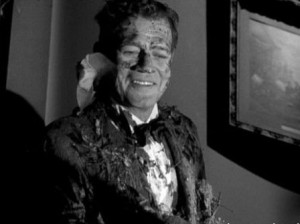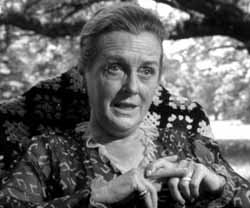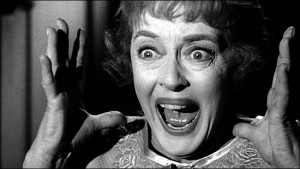A number of strange events begin to unnerve Charlotte even more. There’s a meat cleaver stuck in the floor beside a severed hand; by the time Miriam takes the distraught Charlotte to her room and returns, the cleaver and hand are gone. A silhouette, apparently of John, is seen against the curtains. During the night the song he had written for her is heard on the harpsichord. And wall mirrors are broken. Charlotte shows Miriam a stack of vicious letters sent by Jewel Mayhew.
When a wax replica of John Mayhew’s head falls out of a box Miriam is carrying and bounces down the stairs before an hysterical Charlotte, it’s apparent that Miriam is not all she seems. In the next scene, in fact, the doctor and Miriam review their scheme to derange Charlotte enough to have her committed. The first-time viewer may be genuinely surprised, so well has Olivia de Havilland disguised her true character, further reinforced by her finding one of her dresses slashed.
 From the first, Velma the maid (Agnes Moorehead) is suspicious of Bayliss and Miriam, realizing the doctor has confined Charlotte to her bed with drugs. She tries to help Charlotte escape the house, but Miriam discovers her. Velma, cantankerous and never too subtle—she’s always mimicking her superiors—threatens Miriam with exposure. Not wise. Miriam smashes her over the head with a chair and she falls down the staircase. The murder is passed off as an accident, though Willis is suspicious, as Velma had earlier confided in him.
From the first, Velma the maid (Agnes Moorehead) is suspicious of Bayliss and Miriam, realizing the doctor has confined Charlotte to her bed with drugs. She tries to help Charlotte escape the house, but Miriam discovers her. Velma, cantankerous and never too subtle—she’s always mimicking her superiors—threatens Miriam with exposure. Not wise. Miriam smashes her over the head with a chair and she falls down the staircase. The murder is passed off as an accident, though Willis is suspicious, as Velma had earlier confided in him.
Then the film’s most bizarre sequence. In an elaborate deception, the two cohorts leave a pistol, loaded with blanks, at the harpsichord for Charlotte to find when she is drawn downstairs by Drew impersonating John Mayhew’s singing at the instrument. Appropriately enough (wonderfully coincidental for the schemers’ plan!), Charlotte has an hallucination, dreaming she’s at the ball again in 1927 and her beloved John is coming through the door. She dances with him. But suddenly he’s headless and she fires the gun. It turns out that she’s “killed” the doctor! Miriam arrives on cue to say, “What have you done?!”
As if this isn’t enough to tip Charlotte permanently into insanity, Miriam insists the two of them must dispose of the body, and a lengthy scene follows, flush with suspense and drama. There’s a nervous knock on the door. Willis is calling to extend his condolences over Velma’s death—and do a little snooping on his own. Miriam gets rid of him just in time, as the good doctor, cocooned in a rug, is slouching closer and closer within Willis’ view. There’re arguments and accusations between Charlotte and Miriam as they go about their task.
 All this in slow motion, it seems. As is driving the “body” through the woods. More hysteria, as Miriam shouts for Charlotte to get out of the car and help roll Drew down an embankment into a creek. Dr. Bayliss has a resurrection, of course, returning, now water-soaked and covered in vines and creek debris, to unhinge Charlotte further. Bette Davis executes a long crawl, backwards down the staircase, in histrionic howls and screams. “Ah, ah, ah, ah, ah!” Miriam slinks in to pat Charlotte on the head. “Hush, hush, sweet Charlotte,” she mockingly consoles.
All this in slow motion, it seems. As is driving the “body” through the woods. More hysteria, as Miriam shouts for Charlotte to get out of the car and help roll Drew down an embankment into a creek. Dr. Bayliss has a resurrection, of course, returning, now water-soaked and covered in vines and creek debris, to unhinge Charlotte further. Bette Davis executes a long crawl, backwards down the staircase, in histrionic howls and screams. “Ah, ah, ah, ah, ah!” Miriam slinks in to pat Charlotte on the head. “Hush, hush, sweet Charlotte,” she mockingly consoles.
Eventually, feeling quite pleased with themselves, Dr. Bayliss and Miriam stand in front of the mansion sharing some wine and imagining how nice all that money will be once Charlotte is put safely away. Miriam reveals to Drew that it was she who wrote the letters to Charlotte, for she had been blackmailing Jewel Mayhew all these many years; Miriam had seen Jewel enter the summer house the night of the murder. Miriam says to Drew, “Oh! You mean I shall have to wring my hands in abject misery and humiliation at the disgrace of having a member of our fine old family committed to the local madhouse?” From the balcony, Charlotte overhears all. And another potted plant does the trick—a “double” trick!
In the end, a silent, seemingly happy Charlotte is driven quietly away in a taxi.
Too bad the movie isn’t as interesting, even as dramatic, as the backstage shenanigans—and a look-see into the Davis-Crawford hostility would be time well spent. Director Aldrich’s pace is awfully slow, too “Southern” perhaps, and he takes a long time reiterating the scary tricks played on poor Charlotte, a long time revealing the culprits, whom, surely, the audience must have suspected much earlier.
The plot is a little muddled. When, for example, did Drew and Miriam first agree on their scheme? (It’s assumed before they met at Charlotte’s.) Who slashed Miriam’s dress and why? And, what’s always bothered me, how was Charlotte able to push over those heavy pots? Logic, logic. One isn’t supposed to question such in these kinds of films!
The frenzied, hysterical scenes rattle the furniture of the old mansion. The quiet conversations come off the best. Kellaway and Bette Davis have an extended dialogue, walking together from the little cemetery across the lawn, one of Charlotte’s sane moments. Kellaway, especially, is excellent. Moorehead, for all her bluster, and a Southern accent as much over the top as Davis’, has a certain quality, more of a novelty somehow. She does add what little humor there is in the film.
 But the performance to watch, I’ve always felt, is Mary Astor’s. In the first of her two scenes, she is an unattractive, vicious old lady, leaning on a cane and supported by a black servant. She shouts malice at Miriam: “Well . . . let me tell you . . . that murder starts in the heart, and its first weapon is a vicious tongue.” In her last scene, as if the actress knew it would be her farewell screen appearance—movie, TV or otherwise, though she would live another twenty-three years—she becomes the faded but dignified Southern belle. During an afternoon tea al fresco, with rear projection of an avenue of Southern oaks, borrowed from Gone with the Wind, one might think, she has a lengthy scene with Kellaway. She confesses her failing health and gives him a sealed envelope to open and do with as he sees fit after her death.
But the performance to watch, I’ve always felt, is Mary Astor’s. In the first of her two scenes, she is an unattractive, vicious old lady, leaning on a cane and supported by a black servant. She shouts malice at Miriam: “Well . . . let me tell you . . . that murder starts in the heart, and its first weapon is a vicious tongue.” In her last scene, as if the actress knew it would be her farewell screen appearance—movie, TV or otherwise, though she would live another twenty-three years—she becomes the faded but dignified Southern belle. During an afternoon tea al fresco, with rear projection of an avenue of Southern oaks, borrowed from Gone with the Wind, one might think, she has a lengthy scene with Kellaway. She confesses her failing health and gives him a sealed envelope to open and do with as he sees fit after her death.
The South African Kellaway—I always think of him as Irish, a leprechaun, perhaps!—would be nominated three years later for Guess Who’s Coming to Dinner. Ironically, co-nominee George Kennedy would win the supporting actor honors that year for Cool Hand Luke. Hush . . . Hush, Sweet Charlotte was nominated for seven Oscars, perhaps most inexplicably for black-and-white costume design and for supporting actress Agnes Moorehead.

As for who slashed Miriam’s dress, it was Velma, who didn’t like Miriam and wanted her to leave. Miriam says to her “You seem to know it was ripped – and I didn’t mention it to anyone.” Miriam’s next line, “And it isn’t just the dress” seems to imply that Velma also planted the hatchet (and fake hand) for her to find, not knowing that Charlotte would see it too. I’ve found that part to be a bit far-fetched. Watch it again.
What happens to Charlotte at the end… is she sent to an insane asylum or is she sent to gaol?
She’s carted off to the hoozgow.